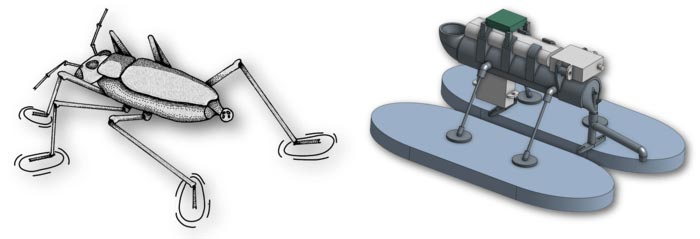Marangoni surfer robots look and move like water bugs

Hassan Masoud and his team, including doctoral student Mitchel Timm, built a robot that can manipulate surface tension to propel itself across the liquid surface with great speed and maneuverability.
Credit: Mitchel Timm/Michigan Tech
From birds in the sky to fish in the sea, nature’s creatures possess characteristics naturally perfected over millennia. Studying them leads engineers to create new technologies that are essential to our way of life today. Mechanical engineers from Michigan Technological University share how they built a tiny, self-powered robot inspired by water-skimming insects.
“Bio-inspired robotic technologies push the boundaries of what we think is possible when it comes to traveling on land, in the air and underwater,” said Hassan Masoud, an expert of biological and bio-inspired fluid mechanics at Michigan Tech. “Yet few robots focus on the air-water interface. Many biological organisms such as insects, arachnids and even bacteria have the ability to stand upon this boundary by taking advantage of surface tension.”
However, among these species, only a few can also manipulate surface tension to propel themselves across the liquid surface with great speed and maneuverability. Masoud and his team, including doctoral student Mitchel Timm, built a robot that can do this — and their work was recently published in Bioinspiration and Biomimetics.
They also wrote a guest blog for Michigan Tech’s Unscripted research blog detailing how their robot uses Marangoni propulsion, a method of generating thrust by creating surface tension gradients.
Journal: Bioinspiration & Biomimetics
DOI: 10.1088/1748-3190/ac253c
Method of Research: Experimental study
Article Title: A remotely controlled Marangoni surfer
Article Publication Date: 9-Sep-2021
Media Contact
Kelley Christensen
Michigan Technological University
kelleyc@mtu.edu
Office: 906-487-2863
All latest news from the category: Power and Electrical Engineering
This topic covers issues related to energy generation, conversion, transportation and consumption and how the industry is addressing the challenge of energy efficiency in general.
innovations-report provides in-depth and informative reports and articles on subjects ranging from wind energy, fuel cell technology, solar energy, geothermal energy, petroleum, gas, nuclear engineering, alternative energy and energy efficiency to fusion, hydrogen and superconductor technologies.
Newest articles

You are What You Eat—Stanford Study Links Fiber to Anti-Cancer Gene Modulation
The Fiber Gap: A Growing Concern in American Diets Fiber is well known to be an important part of a healthy diet, yet less than 10% of Americans eat the minimum recommended…

Trust Your Gut—RNA-Protein Discovery for Better Immunity
HIRI researchers uncover control mechanisms of polysaccharide utilization in Bacteroides thetaiotaomicron. Researchers at the Helmholtz Institute for RNA-based Infection Research (HIRI) and the Julius-Maximilians-Universität (JMU) in Würzburg have identified a…

ASXL1 Mutation: The Hidden Trigger Behind Blood Cancers and Inflammation
Scientists show how a mutated gene harms red and white blood cells. LA JOLLA, CA—Scientists at La Jolla Institute for Immunology (LJI) have discovered how a mutated gene kicks off…



